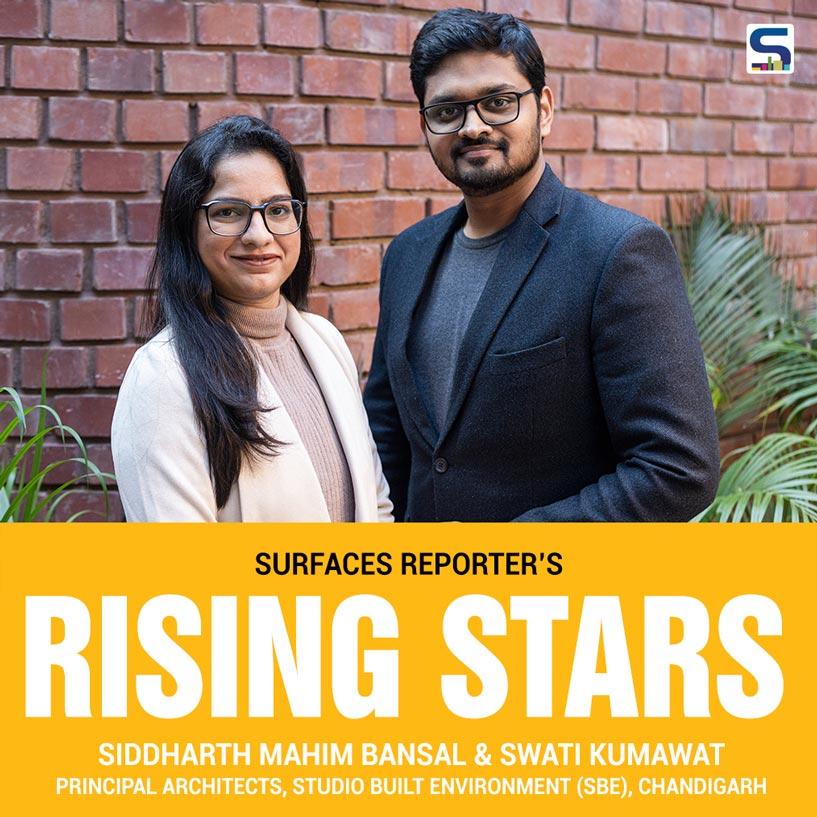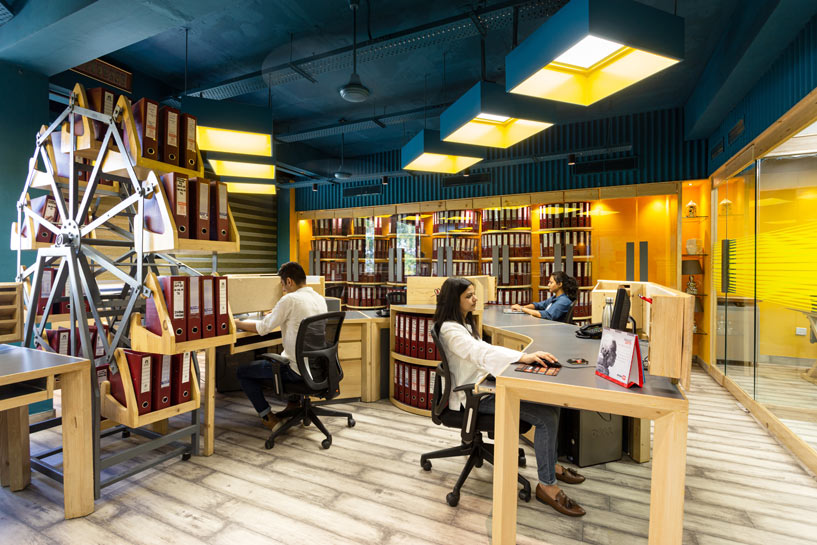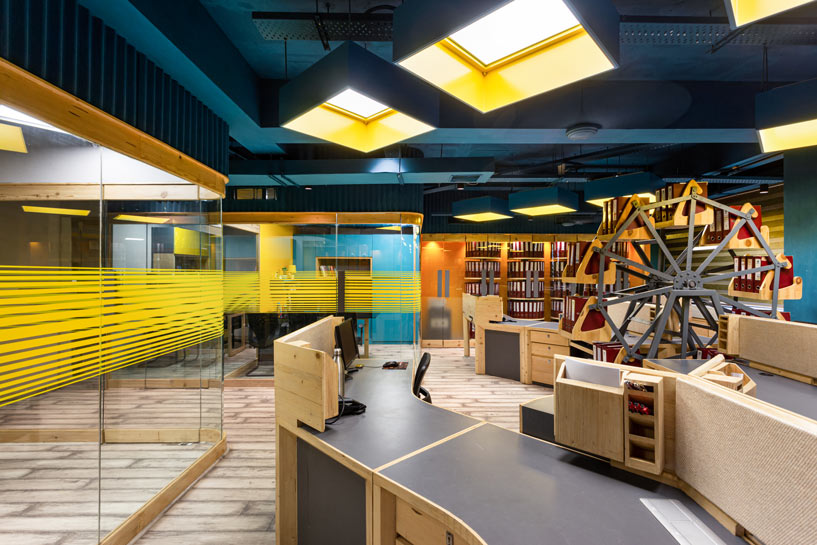
Founded in 2015 by Ar Siddharth Mahim Bansal & Ar Swati Kumawat, both alumni of IIT-Roorkee, SBE has been involved with various innovations & experimentations in the fields of building materials and passive techniques. Having been awarded at both national and international platforms, currently, the firm is handling a vast array of projects ranging from boutique interior design to large-scale architecture projects covering a versatile portfolio from commercial and residential assignments to institutional and healthcare projects.
Tell us about the first project that laid the foundation of your studio.
The Meditation Hall for Sri M Trust was our first project and is very close to our heart since it laid the foundation of the studio. During 2015, when I was exploring the design philosophy and looking out at various works of master architects for the inspiration, I came across a couple of articles, talking about how the city (Chandigarh) has turned dull and monotonous, inferring to master architect Corbusier’s ‘Brutalism’.
Delving deeper, I thought of doing a built-structure that is purely brutalist in nature yet devoid of dull grey concrete and monotonous brickwork. It was our first time experimenting with the Colored Concrete wherein we tried to give a new dimension to the Exposed Brickwork. I remember doing more than a dozen lab trials for getting the right color and testing the same
for the desired strength. Through this project, a small structure of just around 1100 sqft, we tried to respond to the architecture quest and made a statement that it is not the idea of brutalism that brought dullness to the city but the lack of experimentation.
How a good architecture is not necessarily an expensive one, the design is!
Our first project, the Meditation Hall was a design and build assignment for us. It was a budget project. It brought to us an altogether new perspective towards
designing. We worked hard on optimizing the execution costs, yet keeping the experimentation spirit alive. We used corner-broken/ damaged wire-cut bricks to infuse patterns to the otherwise monotonous facade. Instead of investing on plyboard shuttering for exposed concrete work, we used conventional steel shuttering plates and inserted wooden battens in between them, helping us infuse desired patterns. And many other similar attempts to optimize the construction cost, laid the foundation to the studio’s philosophy - A good architecture is not necessarily an expensive one, designing is!
What are your current projects?
A modern bungalow – ‘Neocrete’ in Chandigarh is the first clicks in my mind, as highlighting one particular project is difficult. The construction is in full swing and we are busy optimizing its design; experimenting again with colored concrete, but now in a curved cantilever of more than 16 feet.
Optimization and rationalization on all the fronts, whether from selection of material to the design practicality, became the USP of the studio. We believe that a long-lasting and practical design is the most significant aspect of sustainable architecture.
What was your most challenging project so far?
Though every project come with its own challenges and constraints, Malwa Ortho Hospital, a Super Specialty (Orthopaedics) Hospital at Mukstar (Punjab) probably tops the list. Site conditions (soil) posed as the biggest challenge in this limited-budget project. Water table in Mukstar (Punjab) after rains go to as high as 6 feet below NGL.
Doing a full-fledged services basement was very tricky. We couldn’t afford a slight flaw in workmanship/ site execution so we conceptualized and detailed out basement civil works in a very innovative manner, making it immune to poor workmanship.
Post-Covid price escalation was another major hit for the project. And a lot of things had to be replanned/ conceptualized in order to fit in the project budget including its low-maintenance façade, services and many other items. It was definitely a sight to see this building come to completion.
5 things we do not know about SBE?
1. The term ‘Studio Built Environment’ was coined by neither of us (principal architects). SBE was conceptualized during our under- graduation years at IIT Roorkee by the (in) famous trio —Ar. Arnav Mathur (now Partner, Studio Svarup), Shreyank Vyavahare and myself (Siddharth) and the other two didn’t bother to consult me over the name (:P); though I liked it.
2. Apart from our projects, we experiment a lot on our spaces too. We executed a full-glass-roof skylit conference room at our studio in 2021 which has been the most exciting work/ fun space at SBE. The conference room is the most happening place where we conduct meetings and all the events.
3. We do conduct a lot of knowledge-sharing sessions (tutorials and discussions) internally for our team as well as open-house.
4. Sonia, our facility manager is one of the longest-standing team members who is the soul of our studio. An integral part of our team, she is always there to provide us with everyday essentials, keeps records, manages the studio, and is always there to help. And of course, she makes “the best” Coffee ;)
5. In the initial 2 years of our establishment, in 2015 and 2016, we were so engrossed in R&D that the number of projects that we were actively working on were in fact less than two ;) and it has been quite a journey since.
What is your vision for innovation and experimentation with building materials and passive techniques?
In this information era, new materials and technologies are being introduced in the industry at an exceptional rate which is a challenge for design professionals to match its pace. But at the same time, as designers, we must not stop experimenting. There’s always an ocean of possibilities in technological innovations that should not be neglected. Such innovations and experiments will lay the foundation for the new-age design firms both in terms of business viability by adding uniqueness to the designs and at the same time doing justice to the profession by keeping the spirit of experimentation alive.
How has been the experience of working with students/other architects during the workshop?
The idea of workshops revolved around sharing with the peers and students our learning from the experimentation with materials, construction techniques and passive cooling technologies. Eventually, it also evolved into educational sessions for budding architects addressing the missing link of technical exposure to young professionals. The journey has been a fascinating one so far and, we might as well take this forward in future as a formal vertical.
Tell us about your favorite material/ technology?
Having done extensive research and execution of colored concrete we have been using integral pigmentation in some form or the other in many of our projects. Going beyond concrete, we have started using pigmented mortar as well as pigmented ferro-cement.
Your advice for young architects who are looking to start up their own firm?
Focusing on technical aspects of architecture is something that young studios at times miss given the other vast priorities and multifarious challenges that we face in the profession. A strong intent towards comprehending and questioning conventional construction techniques is something that can pave the way to more meaningful experiments. Being technically correct is the need of the hour.
Your message for SURFACES REPORTER®.
SR breathes the philosophy of collaboration especially when it comes to bridging the gap between the industry and the professionals. WADE 2022 was a testimony to it. We wish SR to keep taking such initiatives and events.
Focusing on technical aspects of architecture is something that young studios at times miss at given the other vast priorities and multifarious challenges that we face in the profession. A strong intent towards comprehending and questioning the conventional construction techniques is something that can pave way to more meaningful experiments.
Projects By Studio Built Environment
DESIGNING A START-UP INCUBATOR EXPLORE HUB
Explore Hub - A startup Incubator located in Chitkara University, Rajpura is a space to interact, ideate, innovate, encourage innovation and entrepreneurships. The space incorporates industrial theme with rustic and rugged finishes. It provides students a environment where they can feel closer to the real life where things can get tough and require hardwork to convert our dreams into reality.
.jpg)
DESIGN THEME
Connecting to the journey of an entrepreneur, the architects have displayed the hierarchy of starting a business by creating different zones, starting from the seating area inspired from carts to luxury cabins. The carts derive power from the ceiling where we can see the connecting wires, which paint a picture of how a startup derives energy from the ecosystem.
.jpg) For the students who aim to occupy the space for a lesser amount of time, the wooden chairs has been provided where as for working long hours there is an option for comfortable cushioned seating.
For the students who aim to occupy the space for a lesser amount of time, the wooden chairs has been provided where as for working long hours there is an option for comfortable cushioned seating.
.jpg) At the entrance of Explore Hub, there is an installation design on the reception wall, where the moving gears have been designed and detailed out delicately similarly to the actual gears.
At the entrance of Explore Hub, there is an installation design on the reception wall, where the moving gears have been designed and detailed out delicately similarly to the actual gears.
.jpg) The startup street is an omphalos of created ideas surrounded by wall murals which guides beginners on a bumpy and daring journey of a start up. It also includes a ramp instead of a steps to enter the space so that the person can focus on the ambience of the area.
The startup street is an omphalos of created ideas surrounded by wall murals which guides beginners on a bumpy and daring journey of a start up. It also includes a ramp instead of a steps to enter the space so that the person can focus on the ambience of the area.
Connecting to the journey of an entrepreneur, the architects have displayed the hierarchy of starting a business by creating different zones, starting from the seating area inspired from carts to luxury cabins.
.jpg) The think tank design gives major thinking vibes, letting the startups to dig a little deeper for innovative ideas. It is designed to inspire creative thinking, such co-working spaces allow productive discussions over a cup of coffee.
The think tank design gives major thinking vibes, letting the startups to dig a little deeper for innovative ideas. It is designed to inspire creative thinking, such co-working spaces allow productive discussions over a cup of coffee.
.jpg) One major challenge in this space was to retrofit the existing shed of canteen which was an temporary structure. Explore hub provides multi- functional spaces inspiring new ideas through collaboration and experimentation.
One major challenge in this space was to retrofit the existing shed of canteen which was an temporary structure. Explore hub provides multi- functional spaces inspiring new ideas through collaboration and experimentation.
Project Details
Project name: Explore Hub
Architect: Studio Built Environment, Chandigarh
Location: Rajpura, Punjab
Photography: Nakul Jain
Design Team: Swati Kumawat & Siddharth Mahim Bansal
Category: Institutional (Interiors)
Completion Year: 2018
Gross Built Area: 5000 sqft
1000 FILE STORAGE AS THE DESIGN THEME
ACCOUNTS -IN-MOTION
Effective space utilization and introducing dynamism to the otherwise mundane accounts, formed the key design parameters while relocating the office of the Accounting Department of Chitkara University, Chandigarh into newly allocated 990 Square feet.
 THEME OF DESIGN
THEME OF DESIGN
The challenge of housing more than 1000 files for ready reference along with 10 spacious workstations and 4 separate cabins drove the design focus towards saving every inch of space. The solution laid in the comprehensive study and evolution of unique file storage and workstation design.
 INDEX FILES
INDEX FILES
The geometry of ‘index files’, typically used in accounting, was analyzed in the design studio and a module for the most efficient index-file-storage unit was developed as a circular disk (in plan). By introducing rotatory mechanism and by adding multiple levels to this circular disk it was transformed into a five-tier file storage column with each accommodating 120 files.
The geometry of ‘index files’, typically used in accounting, was analyzed in the design studio and a module for the most efficient index-file-storage unit was developed as a circular disk (in plan).
10 of such columns placed on either side of the office can carry 1200 files. Carefully designed pivoted glass doors guard this file- storage. The negative space between the adjacent circular units accommodates for the rear swing of these pivoted doors restricting the outer swing only to 10” in the circulation space. This 30” diameter file-rotatory column unit not only offers abundant storage in a small foot print but also offers its users an interesting operating pattern to retrieve files which takes away the tiresome essence of typical office space.
 To enhance this dynamism, a dynamic file storage installation resembling the structure of the traditional ‘Ferris wheel’ takes the centerstage. This 10-cart dynamic assembly, each cart dedicated to each of the 10 workstations, not only provides adobe to the daily-reference files, but the file retrieval process also acts as a stress buster for the accountants through their prolonged working hours.
To enhance this dynamism, a dynamic file storage installation resembling the structure of the traditional ‘Ferris wheel’ takes the centerstage. This 10-cart dynamic assembly, each cart dedicated to each of the 10 workstations, not only provides adobe to the daily-reference files, but the file retrieval process also acts as a stress buster for the accountants through their prolonged working hours.
 Y-shaped clusters of workstations also accommodate circular- sectors placed between workstation-pairs designed to hold files-in-use. Further, to ensure clutter-free worktops, workstations are outfitted with sliding storage accessories designed for keeping stationary items.
Y-shaped clusters of workstations also accommodate circular- sectors placed between workstation-pairs designed to hold files-in-use. Further, to ensure clutter-free worktops, workstations are outfitted with sliding storage accessories designed for keeping stationary items.
 In the ceiling, all utilitarian elements of AC ducts, electrical works etc. have been kept exposed and unified by a teal blue color including the ceiling fans. Corrugated metal sheets in the same color constitute the upper part of the clear glass partitions imparting an industrial character to this workaholic space. Bright ochre-yellow compliments the teal blue to add vibrancy through specific walls of cubicles and backdrop to the file rotary units. Cubicle furniture has been essentially designed visually light complementing the smaller volume of cabins. Mustard colored vinyl strip pattern on the glass partitions give privacy to the supervisor cabins. Rugged-patterned wooden laminate flooring and clear-polished solid wood elements blend well with the overall rustic character. The customized yellow colored lighting fixtures over the workstations help to curb the widespread angle of LED panel lights thus improving the lux levels on the workstations and render the space glare-free.
In the ceiling, all utilitarian elements of AC ducts, electrical works etc. have been kept exposed and unified by a teal blue color including the ceiling fans. Corrugated metal sheets in the same color constitute the upper part of the clear glass partitions imparting an industrial character to this workaholic space. Bright ochre-yellow compliments the teal blue to add vibrancy through specific walls of cubicles and backdrop to the file rotary units. Cubicle furniture has been essentially designed visually light complementing the smaller volume of cabins. Mustard colored vinyl strip pattern on the glass partitions give privacy to the supervisor cabins. Rugged-patterned wooden laminate flooring and clear-polished solid wood elements blend well with the overall rustic character. The customized yellow colored lighting fixtures over the workstations help to curb the widespread angle of LED panel lights thus improving the lux levels on the workstations and render the space glare-free.
Project Details
Project name: ACCOUNTS-IN-MOTION
Architect: Studio Built Environment, Chandigarh
Location: SCO 160–161, Sector 9-C, Chandigarh
Photography: Purnesh Dev Nikhanj
Design Team: Siddharth M. Bansal, Swati Kumawat, Pratibha Batish
Category: Interior Design
Project Completion Year: 2019
Site Area: 990 sq. ft.